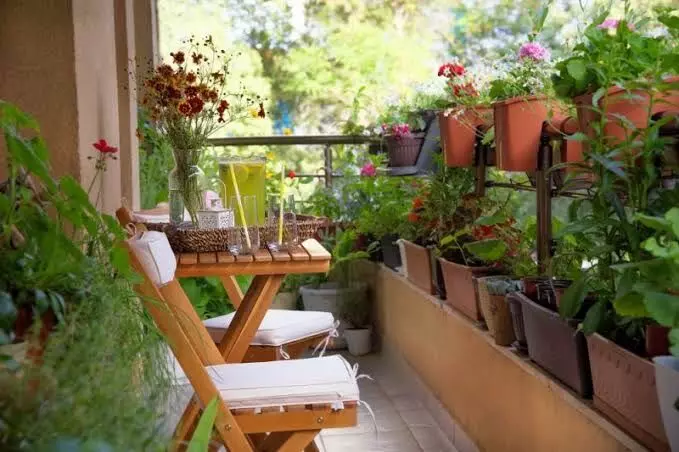Hyderabad’s urban dwellers turn to balcony gardening as green therapy
It is a conscious, slow-growing response to urban burnout, climate anxiety and a yearning for reconnection with nature
By Anoushka Caroline Williams
Hyderabad’s urban dwellers turn to balcony gardening as green therapy
Hyderabad: In a cityscape defined by concrete and glass, an unexpected rebellion is sprouting quietly across India’s high-rises, lush balcony jungles cultivated by city dwellers with little more than pots, compost and patience.
From compact apartment balconies in Mumbai to towering terraces in Hyderabad, the balcony jungle movement is not just about aesthetics. It is a conscious, slow-growing response to urban burnout, climate anxiety and a yearning for reconnection with nature.
Why are Indians turning to balcony gardening?
The shift didn’t happen overnight.
The Covid-19 lockdowns forced millions indoors and sparked a rediscovery of personal space. For many, the only slice of sky they had was their balcony, and slowly, seeds were sown.
“People are realising that growing plants is not just therapeutic, it’s also a political and ecological act in cities where green space is shrinking,” said Aarti Ramnath, an urban ecologist.
Balcony gardening serves multiple purposes:
• It reduces indoor temperatures and enhances air circulation.
• It helps cut food bills through micro-farming.
• It fosters emotional well-being and mindfulness in daily routine.
What makes a balcony jungle?
A balcony jungle is more than a few potted plants. It’s a carefully layered micro-ecosystem of greenery, edible, ornamental, medicinal and often spiritual.
A typical setup may include:
• Climbers and creepers (money plant, morning glory, beans) along railings.
• Vertical shelves stacked with herbs like tulsi, mint, and lemongrass.
• Hanging baskets with flowering plants and air-purifying greens.
• DIY compost bins made from old buckets, turning kitchen waste into soil gold.
For some, it’s also a nostalgic revival. “We had a guava tree growing up, and now I’ve trained one in a drum on my 12th-floor balcony,” shared Neelesh Vyas, a Hyderabad graphic designer turned amateur gardener.
The wellness angle: Not just about plants
What distinguishes this movement is how deeply it’s tied to wellness culture. City dwellers are increasingly treating their balconies as sanctuaries.
“There’s a psychological comfort in nurturing something every day,” said Dr Meera Kodandapani, a clinical psychologist who incorporates nature therapy into her practice.
“Watering plants, observing growth cycles, these are grounding rituals. They help regulate mood, especially in environments marked by noise, pollution, and digital overload.”
Many balcony gardeners report improved sleep, reduced anxiety, and better indoor air quality after starting their green projects.
A movement rooted in sustainability
The balcony jungle trend also intersects with larger concerns about climate change, food security, and sustainable urban living. The plants people grow are often chosen with intention, drought-resistant, pollinator-friendly or locally native species.
There’s also a growing interest in composting and circular waste systems. “In our apartment complex, 18 families contribute kitchen waste to a shared compost hub. We’ve reduced over 70 per cent of our daily waste output,” said Ramnath.
Innovation and design: Making it work in tiny spaces
Space constraints have driven clever innovation. Balconies barely 3 feet wide are being transformed using:
• Vertical grow towers
• Modular racks with wheels
• Self-watering pots
• Hydroponic trays for leafy greens
• Upcycled containers, like paint buckets, crates and PVC pipes
Startups are also getting in on the action. Homegrown brands now sell balcony gardening kits tailored to climate zones, dietary preferences, and time availability. Apps like GrowPal and Plantify offer reminders, pest alerts and even virtual plant doctors.
Challenges and learning curves
This movement isn’t without its setbacks. Common hurdles include:
• Balcony orientation (North-facing balconies receive little direct sun)
• Weight limitations in high-rises
• Water management (especially during monsoon or drought)
• Pest infestations like aphids or mealy bugs
“Gardening humbles you,” said Vyas. “You lose a few plants in the beginning. But then you start observing more, rushing less. It changes your relationship with time.”
From private to public
What started as personal projects are now expanding into shared practices. Community garden clubs have sprung up in housing societies. Seed exchanges, composting collectives and workshops have made balcony gardening a social ecosystem as well.
Balconies are also becoming sites of cultural expression, from decorating pots with Warli art, to growing traditional ingredients like ajwain, betel leaf, or jasmine used in pujas.
“Green space is not just environmental, it’s emotional and cultural,” noted Dr Ramnath. “It connects people to memory, language, ritual, and each other.”
The future of India’s balcony jungles
As urban stressors increase, so will the value of self-grown greenery. Experts predict:
• Integration of solar panels + green walls
• Smart irrigation linked to weather apps
• More government incentives for terrace and balcony farming
• Inclusion of urban greening in climate resilience plans
India’s balcony jungle movement is more than a lifestyle trend; it’s a grassroots environmental response, a mental health tool, and a quiet rebellion against the sterile, hurried pace of urban life.
In the words of Dr. Kodandapani: “Tending to plants reminds us that growth isn’t always fast, and that slowness can be sacred.”
Whether you’re nurturing tulsi in a teacup or tomatoes in a grow bag, the message is clear: the plants are taking over, and perhaps, that’s exactly what we need.